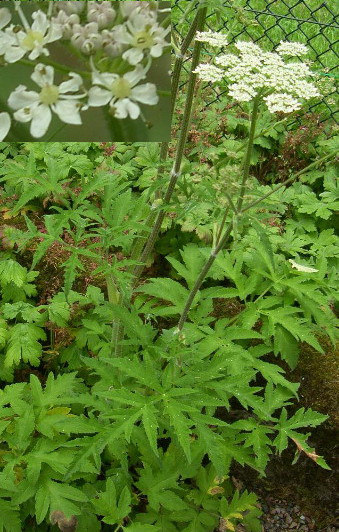Common HogweedScientific Name: Heracleum spondylium |
It is a perennial or sometimes biennial which dies away in the late autumn and comes into growth the following spring. Found at the edges of woods, on road verges and beside paths. In the past it was used as fodder for livestock.
The leaves have 3 to 5 lobes and are covered with hairs. The emerging shoots can be blanched and fried in butter, and have a flavour something like asparagus and parsley. With repeated harvesting new shoots emerge providing a crop throughout spring and early summer. Young leaves collected before fully opened can be cooked like spinich or added to soups and stews.
As the plant develops the stems are hollow with grooves, covered with fine hairs and starting dark red to purple then turning green without any spots. This latter point is important when identifying the plant which can reach a height of one to two metres.The small, white, sometimes pink flowers with 5 petals are carried on flat, umbels with 15 to 20 branches (rays). They are pollinated by flies and midges which are attracted to the scent said to be of pigs, which is probably one reason for the common name. When still in bud at the stem nodes they can be collected and steamed in their papery coverings with a similar flavour as the young shoots.
The green seeds have a pungent flavour. When mature the flavour is of cardamom, orange peel and ginger. They can be used in cakes and for mulling wine.The tap root is tapered with some branching and relatively easily removed. Cooked well they can be used like parsnips. When working with mature plants protective waterproof clothing, gloves and a face visor might be advisable as there are reports of skin rashes and photosensitivity particularly with children and adults with pale or sensitive skin.
If the plant has cast seed in previous years there may be new plants germinating for several years, so vigilance is required to remove them. They are usually within a 4 metre radius, but can be carried further by water courses
Spraying with a systemic weedkiller such as Glyphosate, can be carried out between March and August, but before the plant produces seed, any flowers should be removed. Any regrowth or seedlings which germinate later can be sprayed as well.See also Giant Hogweedwhich is similar but much larger. Ground-Elder and Cow Parsley are in the same Family and has similar flower heads.
